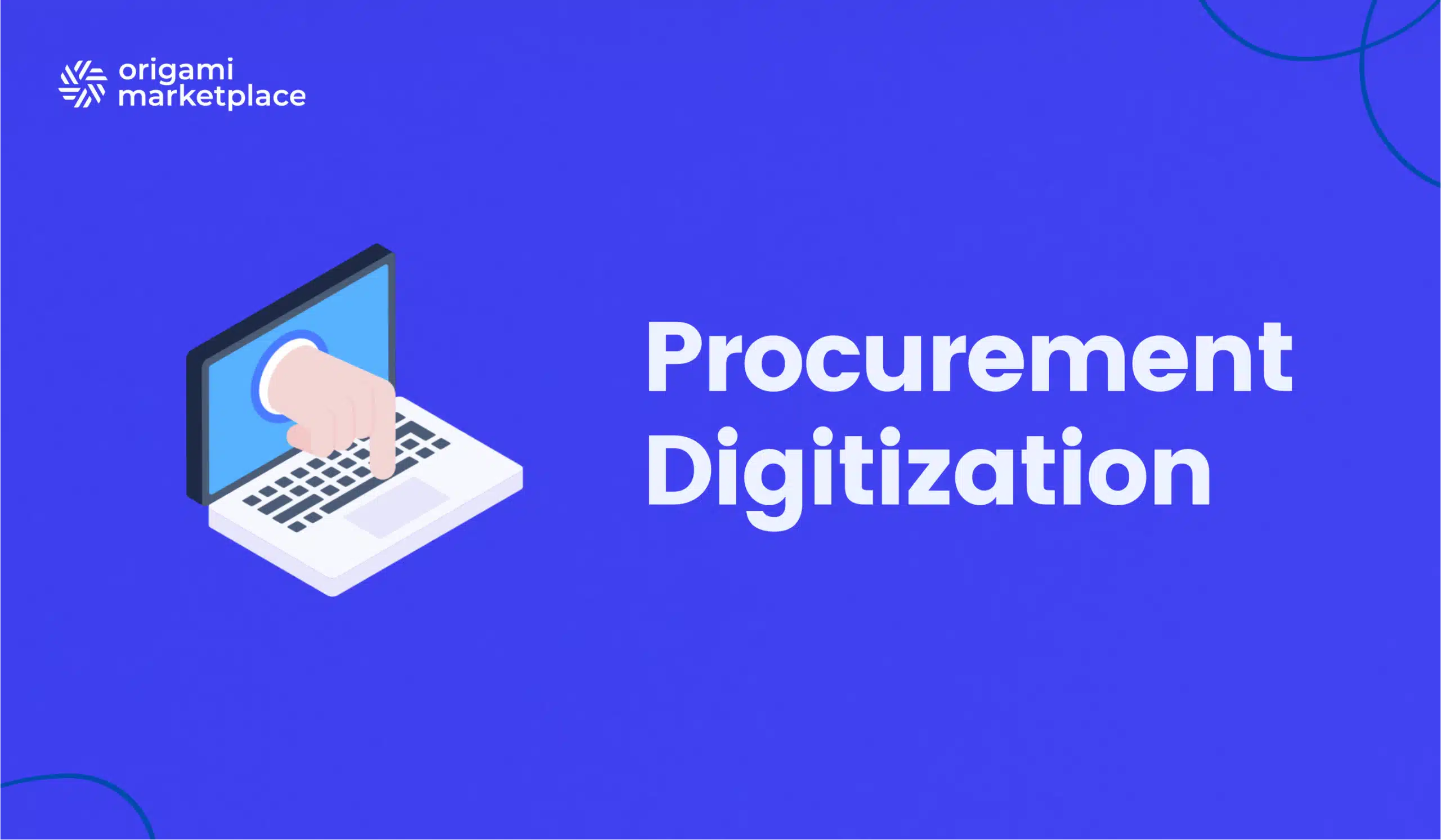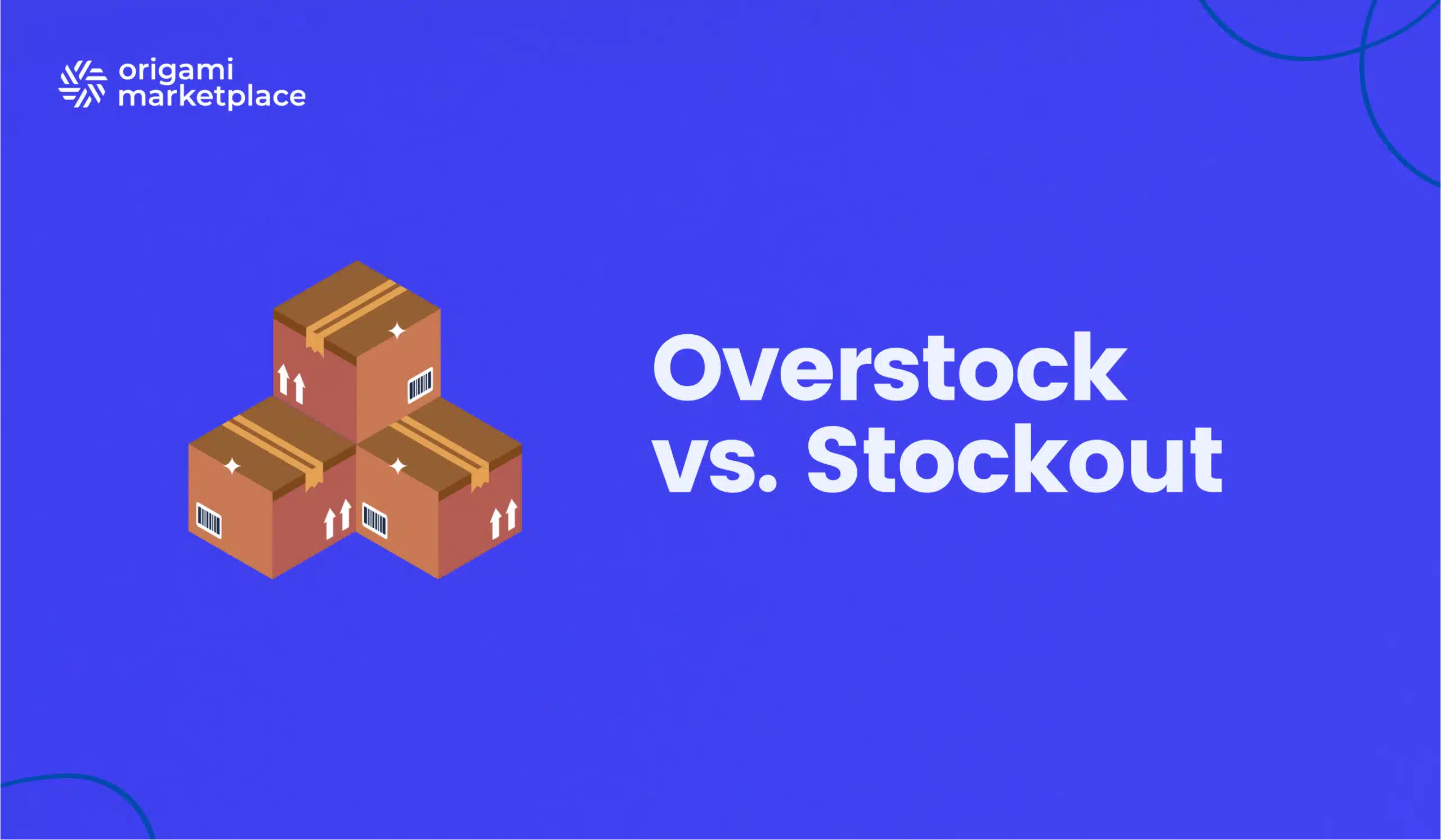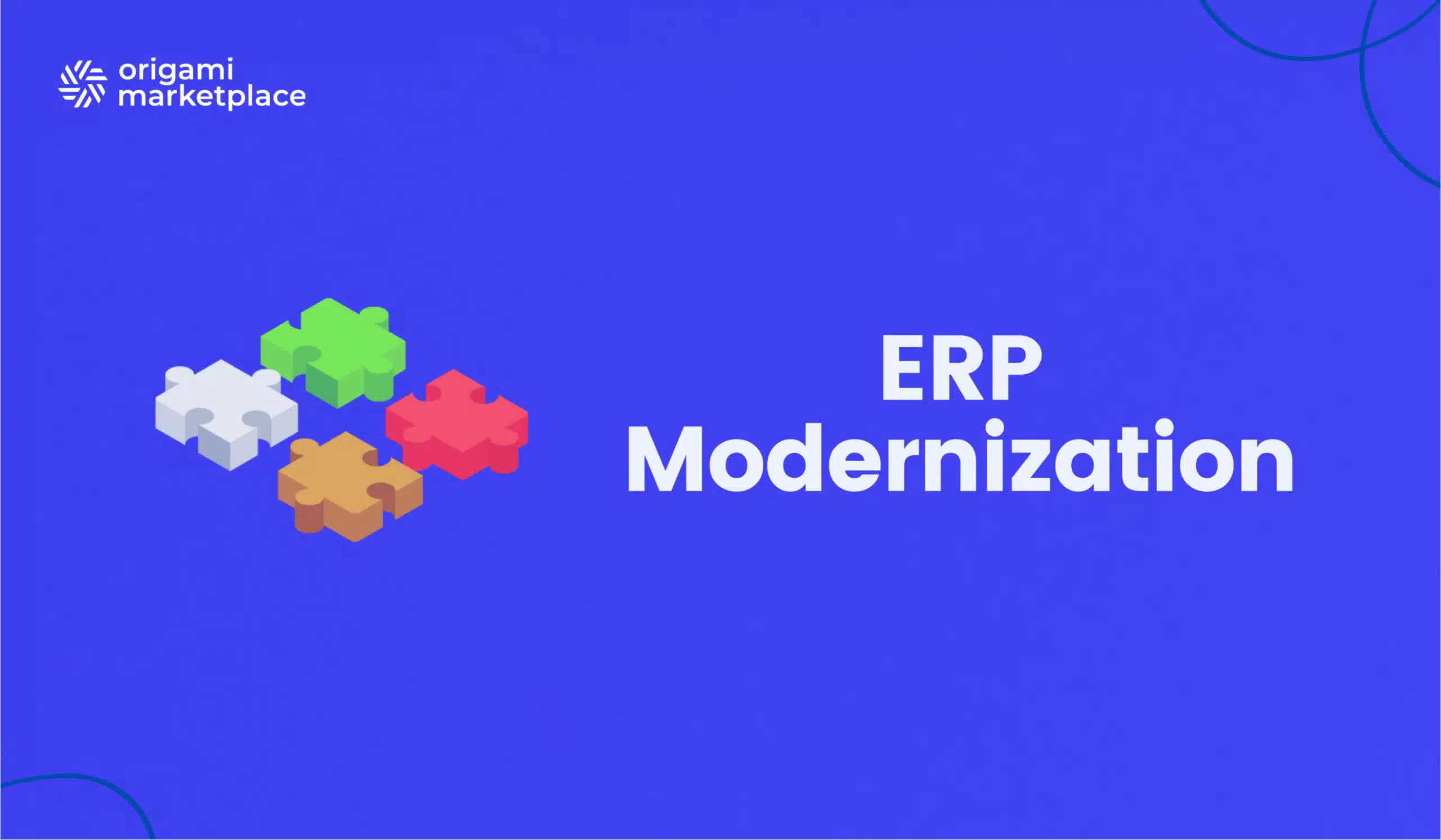10 Best SaaS Marketplace Solutions: 2026 Ultimate Comparison
- Arnaud
- 8 minutes reading
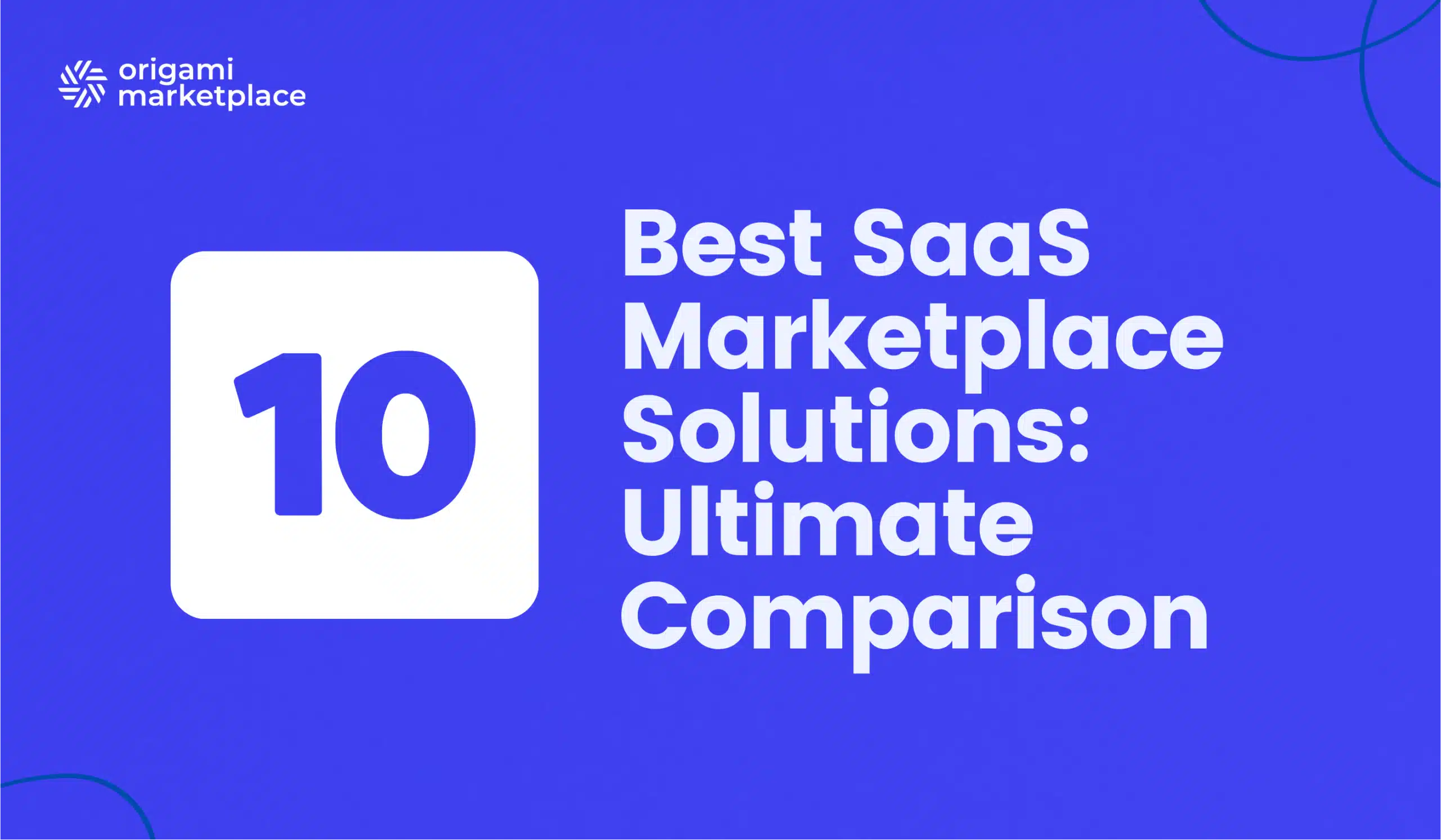
Online marketplaces are experiencing a spectacular boom, now accounting for nearly half of all global e-commerce sales. In France, they generated 31% of e-commerce revenue in 2024, according to the FEVAD 2025 Barometer. This business model is becoming dominant across B2C (e.g., Amazon), C2C (Vinted), and B2B, transforming how companies and consumers interact.
In response to this booming demand, numerous software solutions now make it possible to launch your own marketplace. But should you opt for a turnkey SaaS marketplace solution or for custom open-source development? And what is the best software in 2026 for your specific needs whether you’re a startup, an SME, or a large enterprise?
In this comprehensive guide, we will:
- Compare SaaS vs. open-source marketplace platforms (pros and cons).
- Showcase examples of successful B2B, B2C, and C2C marketplaces.
- Provide a comparison table of the best marketplace software.
- Detail 10 powerful tools, including their features, pricing, and target users.
Ready to find the ideal technical solution for your marketplace project? 🚀
TABLE OF CONTENTS:
- 1. SaaS vs. Open-Source Marketplace: Which is the Better Choice?
- 2. Examples of B2B, B2C, and C2C Marketplaces
- 3. The Advantages of a SaaS Marketplace
- 4. Comparison Table of the 10 Best SaaS Solutions to Create a Marketplace
- 5. Detailed Analysis of the 10 Marketplace Solutions:
- – Origami Marketplace
- – Sharetribe
- – Arcadier
- – CS-Cart Multi-Vendor
- – Kreezalid
- – Shopify + application multivendeur
- – WooCommerce + Dokan
- – Mirakl
- – VTEX
- – Spryker
- 6. SaaS vs. Open-Source, How to Choose?
- Frequently Asked Questions (FAQ)
1. SaaS vs. Open-Source Marketplace: Which is the Better Choice?
Choosing between a SaaS (Software as a Service) platform and an open-source solution is a strategic decision. Each approach directly impacts the required skills, costs, development time, and long-term flexibility of your project. Here is a detailed breakdown of the key trade-offs:
Open-source solutions (like Magento or a fully custom development) offer total freedom of customization. However, this freedom comes with a high demand for technical skills. You will need a dedicated team of developers for the initial build, ongoing maintenance, and security management.
Conversely, SaaS solutions are turnkey platforms, hosted and maintained by the provider. They are designed to be used without any coding skills, allowing you to focus on your core business rather than the underlying technology.
Implementing an open-source solution is typically a longer and more complex process. Every modification or new feature requires significant development time and resources.
In contrast, SaaS solutions are built for agile scalability and rapid deployment. Updates and new features are managed automatically by the provider, ensuring your platform always benefits from the latest innovations without any effort on your part.
The open-source model involves significant upfront fixed costs (development, servers, licenses) and recurring operational costs for maintenance and support.
SaaS solutions operate on a monthly or annual subscription model. The costs are transparent and predictable, which allows you to smooth out expenses over time and avoid massive initial capital expenditure.
The development timeline for an open-source marketplace can range from several months to over a year, delaying your entry into the market.
SaaS solutions are optimized for a fast time-to-market. Some platforms enable a launch in just a few weeks, which is crucial for quickly testing business ideas and gaining a competitive edge.
With an open-source solution, you start from zero and have total control, which is ideal for projects with highly unique and specific requirements.
SaaS solutions, on the other hand, allow you to adapt your business model to a pre-existing, robust platform that is rich with proven features. This enables you to concentrate on your value proposition and business strategy, rather than reinventing the technological wheel.
Ready to turn your B2B, B2C, or C2C marketplace vision into reality?
To help you develop the best platform possible, we’ve gathered all the must-have features, key technical considerations, and best practices in a comprehensive document:
Download the Specifications template 🗒
Perfect for smaller or medium-scale projects without a formal purchasing process. It will help you outline your requirements effectively and streamline your selection process.
Download the Request for Proposal template 📒
Ideal for larger, more complex marketplace projects with a formal purchasing department or advanced procurement policies.
2. Examples of B2B, B2C, and C2C Marketplaces
Understanding the primary marketplace models is essential to position your platform correctly.
🔷 B2B (Business-to-Business) Marketplace
These platforms facilitate transactions between companies. They are defined by large order volumes, long-term relationships, and complex billing processes.
Examples: Alibaba.com, Ankorstore, Amazon Business.
🔷 B2C (Business-to-Consumer) Marketplace
B2C marketplaces connect businesses (sellers) with end consumers. They focus on retail, with an emphasis on the customer experience.
Examples: Amazon, Etsy, Zalando.
🔷 C2C (Consumer-to-Consumer) Marketplace
C2C marketplaces allow individuals to sell or exchange goods and services among themselves, often promoting the circular economy.
Examples: eBay, Vinted, Airbnb.
| Marketplace | Main Model | Type of Products/Services | Target Audience | Key Features |
|---|---|---|---|---|
| Amazon | B2C | Very broad (electronics, fashion, etc.) | Consumers, Businesses | Vast selection, fast delivery |
| Uber | B2C | Transportation services | Consumers | Easy ordering via app, geolocation |
| Airbnb | C2C | Accommodations (lodging) | Individuals (travelers and hosts) | Online booking, review system |
| Alibaba.com | B2B | Wholesale manufactured goods | Businesses | High volumes, negotiation |
| Etsy | B2C / C2C | Handmade, vintage items | Consumers, Artisans | Unique products, creative community |
| Vinted | C2C | Second-hand clothing, accessories | Individuals | Circular economy, buyer/seller protection |
Beyond Traditional Models
Of course, there is a multitude of other more specialized or hybrid marketplace models that enrich the e-commerce ecosystem.
- B2B2C (Business-to-Business-to-Consumer): A company sells a product or service to another company, which then resells it under its own brand to its end customers.
- C2B2C (Consumer-to-Business-to-Consumer): An individual entrusts a good to a platform that handles its reconditioning, storage, and sale to another consumer.
- Service Marketplace: Connects professionals or freelancers with clients needing their skills.
- Data Marketplace: An emerging model where the platform facilitates the purchase, sale, and exchange of datasets and analytics between data providers and companies (e.g., Dawex, Snowflake Data Marketplace).
- Subscription Marketplace: The platform offers access, for a recurring subscription, to a catalog of products or services that consumers can use repeatedly (e.g., some online course marketplaces, clothing rentals).
3. The Advantages of a SaaS Marketplace
Opting for a SaaS solution to create your marketplace presents numerous advantages:
- Integrated business features: Catalog management, sales, payments, seller/buyer accounts, invoicing, etc.
- Easy interconnection: SaaS solutions are designed to integrate with your other software (CRM, ERP, etc.) via APIs and native connectors.
- Hosting, security, and support included: The provider handles technical maintenance, security updates (GDPR, PSD2), and server availability.
- Scalability and regular updates: You automatically benefit from the latest innovations without any effort on your part.
In short, SaaS allows you to quickly launch an operational marketplace and focus on business rather than technology.
Before choosing a SaaS or Open-Source solution, start by defining your business objectives (growth, seller acquisition, internationalization) and your technical constraints. Precise planning upfront will prevent you from having to switch platforms in 2 years. It's a costly mistake I see too often.

Alexandre Duquenoy
→ Speak with our expert
4. Comparison Table of the 10 Best SaaS Solutions to Create a Marketplace
| Solution | Type | Pricing | Ideal for... |
|---|---|---|---|
| Origami Marketplace | SaaS B2B/B2C/C2C & Services | By quote (Starting at €50K) | Custom projects across all sectors (Industrial, Retailers, from SMEs to Large Enterprises) |
| Sharetribe | No-code SaaS | From $99/month | Launching an MVP quickly (small marketplaces) |
| Arcadier | Freemium SaaS | Free, then from $79 | Product or service marketplaces (SMBs) |
| CS-Cart Multi-Vendor | Open-source license | ~$1,450 (lifetime license) | Operators who want control over the code (Tech SMEs) |
| Kreezalid | No-code SaaS | From €129/month | Startups without a technical team |
| Shopify + App | SaaS e-commerce + plugin | Subscription + app cost | E-commerce sites adding a marketplace dimension |
| WooCommerce + Dokan | WordPress plugin | Free (basic version) | Micro-enterprises with a limited budget |
| Mirakl | Headless PaaS | By quote (Starting at €200k) | Large retail / industrial accounts |
| VTEX | Unified commerce SaaS | By quote (Starting at €100k) | Omnichannel retailers and global projects (enterprise) |
| Spryker | Headless PaaS (modular) | By quote (Starting at €150k) | Custom-built marketplaces with a dev team |
The data concerning the solutions above is sourced from our active monitoring. It is subject to change since its collection date and we are not responsible for its real-time accuracy.
5. Detailed Analysis of the 10 Marketplace Solutions










🔷 Origami Marketplace
Origami Marketplace is an all-in-one French SaaS solution designed for marketplace operators. Flexible and scalable, it allows for the creation of B2C, B2B, C2C, or Service marketplaces and adapts to the specifics of each project. Thanks to its modular and API-first architecture, it can easily evolve from one model to another or operate them simultaneously, while integrating with existing IT systems.
- Advantages: As former operators themselves, the Origami team knows the field. The solution is turnkey yet highly customizable. Rapid deployment (around 4-6 months), supported by experts. Secure and compliant (GDPR/PSD2). Designed to be scalable and robust, it supports high volumes and allows for unified management of multiple sales channels.
- Limitations: A premium solution that operates on a quote basis; no self-service offer.
- Who it’s for: Industrial companies, retailers, SMEs, and large enterprises looking to quickly launch a robust multi-vendor or multi-supplier platform that can scale and integrate into their omnichannel strategy, without worrying about technical complexity.
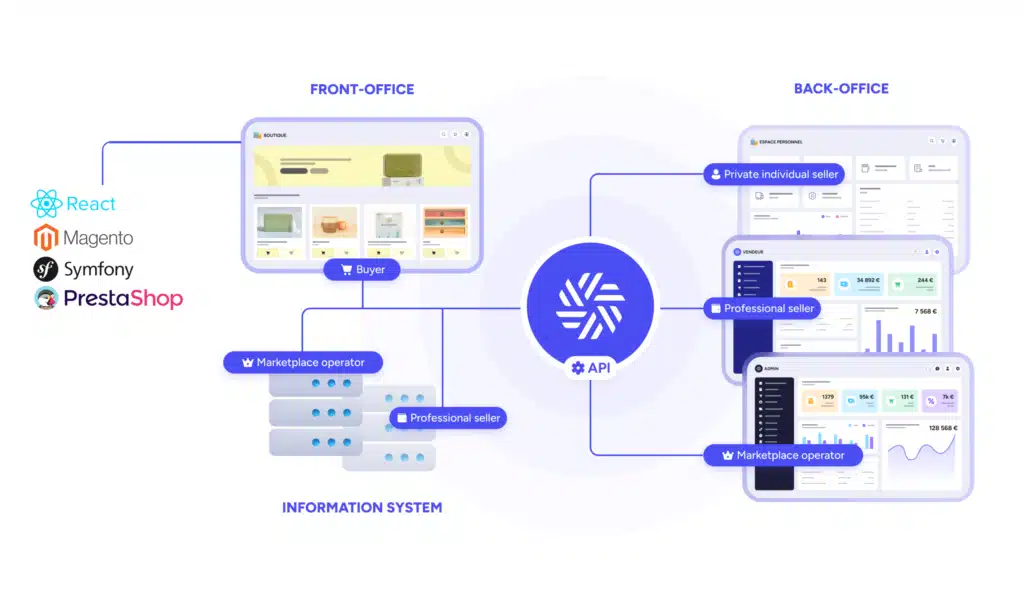
🔷 Sharetribe (SaaS no-code, marketplace in a few clicks)
Sharetribe offers two products: Sharetribe Go (no-code SaaS solution) and Sharetribe Flex (headless version via API). It allows you to create a marketplace in minutes, with no technical skills.
- Advantages: Very simple to use, perfect for launching an MVP quickly. Clear admin interface and good documentation.
- Limitations: Limited customization on the basic offer (Go). Less suitable for high growth or complex needs without upgrading to Flex (which requires development).
- Who it’s for: Entrepreneurs and small businesses wanting to test a marketplace idea (niche products, local services) without a heavy investment.
🔷 Arcadier (SaaS freemium, multi-purpose templates)
Arcadier is a SaaS platform that allows for the creation of marketplaces for selling goods, services, or rentals using adapted templates.
- Advantages: Easy to get started, with reasonable fees (freemium plan available). Good feature-to-price ratio for starting out.
- Limitations: Limited customization. Can become costly if you need advanced features via the API.
- Who it’s for: Small local or specialized marketplaces with a tight budget.
🔷 CS-Cart Multi-Vendor (Open-source license, self-hosted)
CS-Cart Multi-Vendor is an open-source marketplace software (PHP) available with a perpetual license. You buy the software once and install it on your own server.
- Advantages: Extremely comprehensive (over 500 native functions) and total control over the code and hosting. No mandatory monthly fees (long-term economic model).
- Limitations: Requires technical skills for installation, maintenance, and customization. The initial cost is not negligible.
- Who it’s for: Established businesses with a long-term vision that want to own their platform (with an in-house technical team or a service provider).
🔷 Kreezalid (French no-code SaaS, specialized in MVPs)
Kreezalid is a French provider offering a SaaS solution to create a marketplace without coding. Focused on MVPs, it emphasizes an intuitive interface.
- Advantages: Simplicity of use and speed of setup. Attractive and scalable pricing. Customer support in French.
- Limitations: Fewer plugins and possibilities than more mature solutions. May show its limits on very complex projects.
- Who it’s for: Startups and individual entrepreneurs who want to quickly test and launch a niche marketplace.
🔷 Shopify + Multi-vendor Application
It is possible to transform a Shopify site into a marketplace using third-party applications like “Multi Vendor Marketplace.”
- Advantages: Easy integration for those who already have a Shopify store. You retain the user-friendliness and reliability of the Shopify ecosystem.
- Limitations: Does not equal a true native marketplace platform. Limited scalability if you are managing thousands of vendors. Accumulated costs (Shopify subscription + app).
- Who it’s for: E-merchants on Shopify who want to expand their business by hosting partner vendors without changing platforms.
🔷 WooCommerce + Dokan (Marketplace via WordPress)
The combination of WooCommerce + the Dokan plugin is a popular open-source solution for creating a marketplace on WordPress.
- Advantages: Very low startup cost (Dokan has a free version). High flexibility thanks to the WordPress ecosystem.
- Limitations: Requires robust hosting and rigorous technical maintenance (updates, security). Stability can be a challenge.
- Who it’s for: Those on a small budget who have some web knowledge and aren’t afraid to manage the technical side.
🔷 Mirakl (Headless PaaS platform, for large enterprises)
Mirakl is THE benchmark for enterprise marketplaces. This cloud solution is aimed at large accounts (retailers, industrial companies) that want integration with their existing IT systems.
- Advantages: Ultra-comprehensive and modular. Proven by the biggest names (Darty, Carrefour, Walmart). Security and robustness for massive volumes.
- Limitations: Very high price (several hundred thousand euros per year). Heavy and complex IT integration project.
- Who it’s for: Large corporations and mid-caps for whom the marketplace is a strategic lever on a very large scale.
🔷 VTEX (Unified commerce platform)
VTEX is a cloud e-commerce platform that natively integrates marketplace capabilities. It targets companies seeking a scalable and omnichannel infrastructure.
- Advantages: Allows for the centralization of all channels (store, marketplace, B2B) on a single platform. Very flexible and robust for traffic peaks.
- Limitations: Significant cost, reserved for medium and large companies. Technical learning curve.
- Who it’s for: Large-scale retailers and brands aiming for an integrated omnichannel strategy.
🔷 Spryker (Modular headless PaaS, specialized in custom builds)
Spryker is a German platform focused on a headless and modular architecture. It allows for the creation of an ultra-customized marketplace.
- Advantages: Almost limitless customization. Rapid deployment speed for a custom solution thanks to ready-to-use modules.
- Limitations: Absolutely requires a team of developers for implementation and maintenance. High cost.
- Who it’s for: Large-scale, custom-built projects with very specific needs not covered by standard solutions and which have a substantial IT budget.
6. SaaS vs. Open-Source, How to Choose?
In 2026, the choice of your marketplace solution depends above all on your objectives, resources, and constraints.
- To test an idea quickly without technical skills, opt for a no-code SaaS solution (Sharetribe, Kreezalid).
- To scale a business with a need for customization, advanced SaaS (Origami Marketplace) or open-source (CS-Cart) solutions are more suitable.
- For large corporations with complex IT systems, enterprise platforms (Mirakl, VTEX, or Origami Marketplace) provide the necessary functional depth.
The best solution is the one that meets YOUR needs. Consider scalability, the quality of customer support, and the total cost of ownership over 3 to 5 years. Don’t hesitate to ask for demonstrations. The right platform will give you a solid technical foundation to grow with confidence.
Not sure which technology or marketplace model to adopt?
Let’s discuss it. Our expertise is not limited to the tool. We help you structure your project with the right methodology to ensure its success.

FAQ – Frequently Asked Questions
SaaS allows you to benefit from a proven and immediately operational solution. You save precious time on the time-to-market. Furthermore, SaaS spares you from technical complexity: the provider handles updates, security, and regulatory compliance. It is a choice of simplicity and speed.
Costs vary widely from around a hundred dollars per month for simple no-code tools to several hundred thousand euros annually for enterprise platforms like Mirakl. The price depends on the features, transaction volume, and level of customization required.
There is no one-size-fits-all solution.
- For a quick no-code launch, Sharetribe or Kreezalid are excellent options.
- For a turnkey, scalable, and customizable marketplace, Origami Marketplace is one of the most complete and flexible solutions on the market, able to support B2C, B2B, and C2C with a high level of guidance.
- For large enterprises, Mirakl is the leader in retail, but it does not offer more features than Origami Marketplace or VTEX, apart from options like Mirakl Ads, for example.
The best solution is the one that matches your priorities (features, budget, support).
Yes, reputable SaaS providers handle security and regulatory compliance (like GDPR and PSD2) as a core part of their service. They manage all the necessary technical updates to keep your platform and its data safe.
Absolutely. Many leading SaaS solutions (such as Origami Marketplace, Mirakl, and VTEX) are specifically designed with powerful features to handle the complexities of B2B transactions, including quote management, tiered pricing, and specific payment terms.
The 1-Minute Takeaway ⏱️
SaaS vs. Open-Source: The Verdict
For a fast, secure launch without a dedicated technical team, SaaS is the clear winner for the majority of projects. Open-Source offers total freedom but requires significant budget, time, and developer resources.
Which SaaS for Which Project in 2026?
- To test an idea or launch an MVP: No-code solutions like Sharetribe or Kreezalid are ideal. Simple, fast, and affordable.
- For an ambitious and scalable project (SME/Mid-Cap): A robust and customizable SaaS solution like Origami Marketplace is the most sustainable choice to combine speed with custom features.
- For very large enterprises (Retail, Industry): Enterprise platforms like Mirakl, VTEX, or Origami Marketplace are designed for complex integrations and massive volumes.
The Final Advice: The “best” tool doesn’t exist. The right choice for YOU depends on 3 key criteria: your budget, your launch timeline, and your need for customization.
